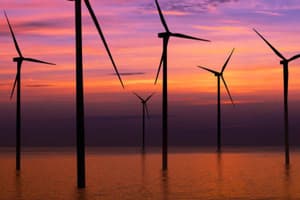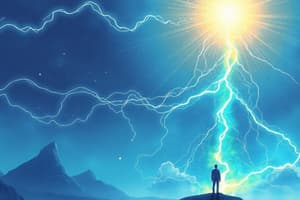Podcast
Questions and Answers
What type of energy is associated with a moving car?
What type of energy is associated with a moving car?
- Chemical Energy
- Kinetic Energy (correct)
- Thermal Energy
- Potential Energy
Which form of energy is released during chemical reactions?
Which form of energy is released during chemical reactions?
- Electrical Energy
- Kinetic Energy
- Chemical Energy (correct)
- Thermal Energy
What happens to potential energy as an object falls from a height?
What happens to potential energy as an object falls from a height?
- It remains unchanged.
- It is lost completely.
- It transforms into kinetic energy. (correct)
- It converts to thermal energy only.
In which scenario would you find elastic potential energy?
In which scenario would you find elastic potential energy?
What explains why a hot spoon cools when placed in cold water?
What explains why a hot spoon cools when placed in cold water?
Which process converts sunlight into chemical energy?
Which process converts sunlight into chemical energy?
What does the Law of Conservation of Energy state?
What does the Law of Conservation of Energy state?
What type of energy cannot be seen directly but is associated with the movement of electrons?
What type of energy cannot be seen directly but is associated with the movement of electrons?
What is the primary function of a convex lens?
What is the primary function of a convex lens?
How does reflection occur when light hits a mirror?
How does reflection occur when light hits a mirror?
What happens to light when it passes through a prism?
What happens to light when it passes through a prism?
Which force opposes motion when two surfaces come into contact?
Which force opposes motion when two surfaces come into contact?
Which law of motion describes an object's tendency to resist changes in its state of motion?
Which law of motion describes an object's tendency to resist changes in its state of motion?
What role do cones in the human eye play?
What role do cones in the human eye play?
Which type of lens is thinner in the center and causes light rays to diverge?
Which type of lens is thinner in the center and causes light rays to diverge?
What is the primary difference between transverse waves and longitudinal waves?
What is the primary difference between transverse waves and longitudinal waves?
According to Newton's Second Law, what factors affect an object's acceleration?
According to Newton's Second Law, what factors affect an object's acceleration?
Which statement correctly describes amplitude?
Which statement correctly describes amplitude?
What happens to sound waves in a vacuum?
What happens to sound waves in a vacuum?
Which option provides an example of a light source?
Which option provides an example of a light source?
How does frequency affect sound waves?
How does frequency affect sound waves?
Which phenomenon occurs when light travels from air into water?
Which phenomenon occurs when light travels from air into water?
What best describes wavelength in relation to sound waves?
What best describes wavelength in relation to sound waves?
Which type of wave can travel through a vacuum?
Which type of wave can travel through a vacuum?
What is the primary function of acids in terms of taste and electrical conductivity?
What is the primary function of acids in terms of taste and electrical conductivity?
Which statement correctly describes the structure of atoms?
Which statement correctly describes the structure of atoms?
What are decomposers primarily responsible for in an ecosystem?
What are decomposers primarily responsible for in an ecosystem?
Which variable in an experiment is manipulated to observe its effect?
Which variable in an experiment is manipulated to observe its effect?
What effect does the Earth's axial tilt have on seasonal changes?
What effect does the Earth's axial tilt have on seasonal changes?
Which group of elements typically conducts electricity and is malleable?
Which group of elements typically conducts electricity and is malleable?
What happens to litmus paper when it comes in contact with bases?
What happens to litmus paper when it comes in contact with bases?
Which layer of the Earth is solid and forms the outermost layer?
Which layer of the Earth is solid and forms the outermost layer?
Flashcards
Kinetic Energy
Kinetic Energy
Energy of motion, depends on speed and mass.
Potential Energy
Potential Energy
Stored energy that can be converted to kinetic energy.
Gravitational Potential Energy
Gravitational Potential Energy
Potential energy due to an object's height.
Elastic Potential Energy
Elastic Potential Energy
Signup and view all the flashcards
Chemical Energy
Chemical Energy
Signup and view all the flashcards
Thermal (Heat) Energy
Thermal (Heat) Energy
Signup and view all the flashcards
Electrical Energy
Electrical Energy
Signup and view all the flashcards
Law of Conservation of Energy
Law of Conservation of Energy
Signup and view all the flashcards
Transverse Waves
Transverse Waves
Signup and view all the flashcards
Longitudinal Waves
Longitudinal Waves
Signup and view all the flashcards
Amplitude
Amplitude
Signup and view all the flashcards
Frequency
Frequency
Signup and view all the flashcards
Wavelength
Wavelength
Signup and view all the flashcards
Sound Waves
Sound Waves
Signup and view all the flashcards
Light Waves
Light Waves
Signup and view all the flashcards
Light Sources
Light Sources
Signup and view all the flashcards
Reflectors
Reflectors
Signup and view all the flashcards
Concave Lens
Concave Lens
Signup and view all the flashcards
Convex Lens
Convex Lens
Signup and view all the flashcards
Reflection
Reflection
Signup and view all the flashcards
Refraction
Refraction
Signup and view all the flashcards
Visible Spectrum
Visible Spectrum
Signup and view all the flashcards
Reflection and Absorption (Color)
Reflection and Absorption (Color)
Signup and view all the flashcards
Gravitational Force
Gravitational Force
Signup and view all the flashcards
Frictional Force
Frictional Force
Signup and view all the flashcards
Newton's First Law (Inertia)
Newton's First Law (Inertia)
Signup and view all the flashcards
Newton's Second Law
Newton's Second Law
Signup and view all the flashcards
Newton's Third Law
Newton's Third Law
Signup and view all the flashcards
Acids
Acids
Signup and view all the flashcards
Bases
Bases
Signup and view all the flashcards
Study Notes
Energy and Its Forms
- Kinetic Energy: Energy of motion. Determined by speed and mass. Examples: car driving, wind, moving water in rivers.
- Potential Energy: Stored energy that converts to kinetic energy when released.
- Gravitational Potential Energy: Higher for objects at greater heights. Example: Rock on a cliff.
- Elastic Potential Energy: Stored in objects like stretched rubber bands or compressed springs.
- Chemical Energy: Stored within the bonds of atoms and molecules. Released during chemical reactions. Examples: food, gasoline.
- Thermal (Heat) Energy: Internal energy of an object due to particle movement; higher movement means more heat. Example: Boiling water vs. room temperature water.
- Electrical Energy: Movement of electrons through a conductor like a wire. Examples: Batteries, power outlets, generating electricity via fossil fuels, hydropower, and wind turbines.
- Law of Conservation of Energy: Energy cannot be created or destroyed, only transferred or transformed. Example: Roller coaster potential energy converting to kinetic energy as it descends.
Waves
- Transverse Waves: Particles vibrate perpendicular to the direction of the wave. Examples: Light waves, microwaves, X-rays.
- Longitudinal Waves: Particles move parallel to the direction of wave travel. Example: Sound waves.
- Amplitude: Maximum displacement of particles from their rest position. Higher amplitude means louder sound or brighter light.
- Frequency: Measured in Hertz (Hz). Higher frequency results in higher pitch in sound (violin) or lower frequencies result in deeper sounds (bass guitar).
- Wavelength: The distance between two successive crests or troughs. Longer wavelengths in sound create lower pitches while shorter wavelengths create higher pitches.
Sound vs. Light
- Sound Waves: Require a medium like air or water to travel. Cannot travel through a vacuum. Travel at about 343 meters per second in air, faster in water and solids.
- Light Waves: Can travel through a vacuum at about 300,000 kilometers per second. Speed of light changes when entering different materials, causing refraction like a straw appearing bent in water.
Light and Optics
- Light Sources: Emit their own light. Examples: Sun, fireflies, light bulbs, candles. Bioluminescence in some animals.
- Reflectors: Reflect light. Example: Moon reflecting sunlight. Mirrors reflect light based on a smooth surface.
- Concave Lens: Thinner in the center, causing light to diverge. Makes objects appear smaller. Used in flashlights to spread light.
- Convex Lens: Thicker in the center, causing light to converge and magnify objects. Found in microscopes, cameras, and reading glasses.
- Reflection: Bouncing of light off a surface like a mirror. Angle of incidence equals angle of reflection.
- Refraction: Bending of light when passing from one medium to another. Causes objects underwater to appear closer to the surface than they are.
How We See Color
- Visible Spectrum: White light made up of colors with different wavelengths. Split into a rainbow using a prism (red, orange, yellow, green, blue, indigo, violet).
- Reflection and Absorption: We see colors because objects reflect specific wavelengths of light. Example: Red apple reflects red light, absorbs other colors. Black absorbs all, white reflects all.
- Human Eye Structure: Rods detect light and darkness. Cones detect color (red, green, blue). Pupil controls light entry. Lens focuses light onto retina, which processes images sent to the brain.
Forces and Motion
- Types of Forces:
- Gravitational Force: Pulls objects toward Earth's center. Keeps planets in orbit and causes objects to fall.
- Frictional Force: Occurs when two surfaces touch, opposing motion. Differs between surfaces (sandpaper vs. ice).
- Applied Force: Force applied by a person or object like pushing or pulling a door.
- Newton's Laws of Motion:
- First Law (Inertia): Objects resist changes in motion. Example: Passengers in a car jerking forward when it stops.
- Second Law (F=ma): Acceleration depends on mass and applied force. Pushing a light box results in faster movement than pushing a heavier box.
- Third Law: Equal and opposite forces. Example: Rocket launches, exhaust gases push down, the rocket moves up.
Acids, Bases, and pH Scale
- Acids: Sour taste, conduct electricity. Examples: Lemon juice, citric acid, hydrochloric acid.
- Bases: Slippery feel, bitter taste. Examples: Soap, ammonia.
- pH Scale: Logarithmic scale, each step represents a tenfold difference in acidity or alkalinity. Litmus paper turns red in acids and blue in bases.
Periodic Table
- Atoms: Consists of a nucleus (protons with positive charge, neutrons with neutral charge), and electrons with a negative charge orbiting around.
- Groups and Periods: Groups have similar properties, periods share the same electron shells. Metals are generally conductive and malleable, non-metals are brittle.
- Important Elements:
- Carbon: Present in all life forms.
- Oxygen: Necessary for breathing.
- Iron: Essential for blood oxygen transport.
Scientific Investigation
- Hypothesis testing: Developing a testable prediction that can be confirmed or refuted.
- Experiment Variables:
- Independent Variable: Changed factor.
- Dependent Variable: Observed result.
- Control Variables: Consistent factors for reliable results.
Ecology and Ecosystems
- Producers, Consumers, Decomposers: Producers (plants) create food through photosynthesis. Consumers eat producers or other animals. Decomposers recycle nutrients.
- Food Webs: Illustrate interconnected energy flow, disruptions like predator removal affect population balance.
Earth and Space Science
- Earth's Layers:
- Crust: Outer solid layer.
- Mantle: Semi-solid, moving plates.
- Core: Iron-rich center with solid and liquid layers.
- Solar System: Planets in order, with Earth's seasons and day/night cycles caused by its axial tilt and orbit around the sun.
Studying That Suits You
Use AI to generate personalized quizzes and flashcards to suit your learning preferences.




